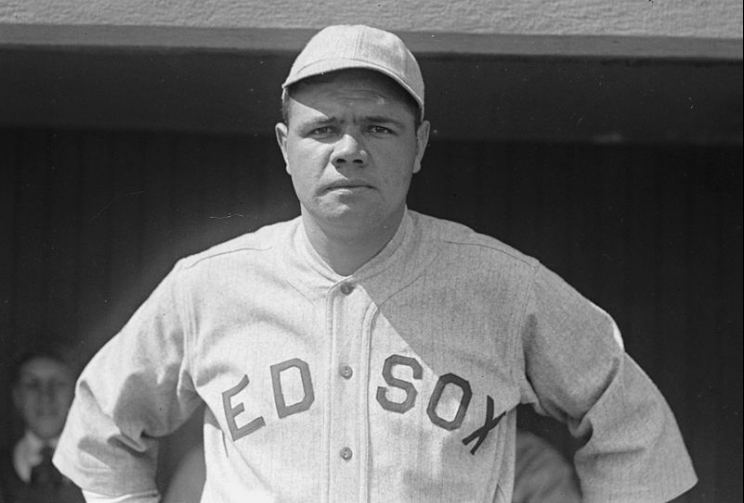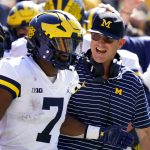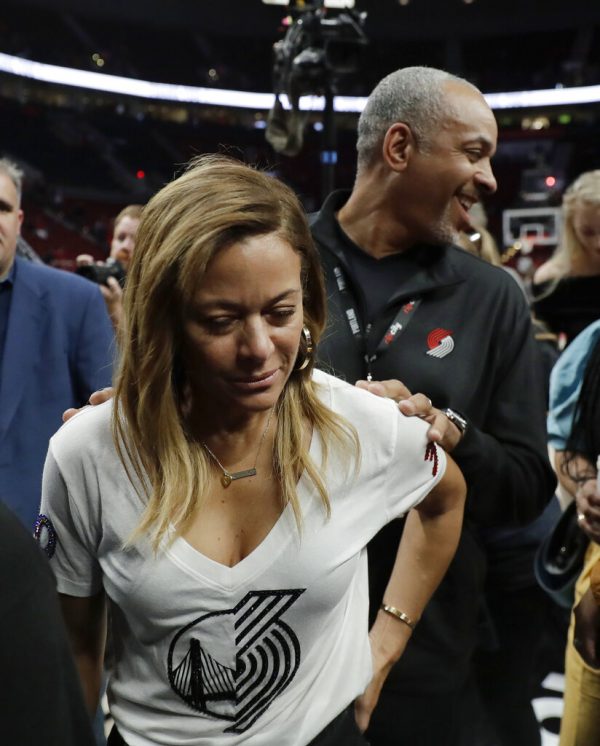A war, a pandemic, a star pitcher switching positions to become a legendary hitter and a potential scandal involving a team throwing the World Series would make for a crazy decade of baseball. That all happened in a single year.
The Babe’s Transition from Star Pitcher to Star Hitter Included a Health Scare
It is no feat of trivia expertise to know Babe Ruth was a pitcher before becoming the greatest hitter of all time. Most are probably even aware that he was a legitimately great pitcher — he started 140 games from 1915 to 1919 with a 2.16 ERA and 20.8 pitching WAR. What may be a bit less known, however, is how bonkers Ruth’s transition from pitcher to hitter actually was.
It was not quite like The Natural where a former great pitcher got a few licks in batting practice and suddenly becomes Roy Hobbs. Rather, Ruth got a few licks in batting practice and gradually became Roy Hobbs.
There was a considerable amount of time where Ruth was both one of the best pitchers in the league and the best home run threat. In fact, 1918 was the first year Ruth led the league in home runs — with 11. He also pitched 166 1/3 innings and went 13-7. He would lead in dingers again the league the next year with 27 while again pitching over 100 innings. And then he would hit 54, 59, 35, 41, 46, 25, 47, 60, 54, 46, 49, 46, 41 and 34 before finally giving in to Father Time.
So yes, the transition was successful. But there was also the whole matter of worldwide crises which made Ruth’s rise to stardom a bit, shall we say, secondary.
The world was at war in 1918 and as a result, Congress and President Woodrow Wilson effectively placed a gag order on all negative talk of the United States government’s performance. The Sedition Act made criticism of the powers that be a crime, and Wilson founded the Committee on Public Information as a stream of positive press from the government to the public. Unsurprisingly, this had instant adverse consequences. We will get to that in a second.
War was so prevalent on the minds of the people that many athletes left sport to either go off to war or take on more war-minded jobs in factories, etc. As such, teams were hurting for talent to fill rosters. And a growing problem was the level of dormancy of information of a certain rising public health crisis.
The flu epidemic was starting to hit the United States, but due to either lack of consideration of the threat or refusal to reveal the threat, the American people were ill-prepared for its arrival. They had no information as to the real severity, and as people started getting sick in waves, they were told the equivalent of “take a Nyquil, get some sleep and get your ass back on the line.”
And sports were not immune. A number of players were infected with the flu, including multiple Red Sox players, and yet concern still had not arisen. More on the minds of Red Sox brass was the fact that roughly a dozen players had joined the war effort and fielding a team was becoming nigh impossible.
Luckily, the young pitcher Ruth stepped up in batting practice on one fateful day. Thunderstorms had already led to the day’s game being canceled, but managers still had their teams take their cuts. And Ruth used the opportunity to showcase a different brand of hitting.
Prior to Ruth’s iconic style of swing – massive hand hitch, slight uppercut, head flying towards right field – bats were little more than fly swatters. Swings were downward and slappy, beating the ball into the dirt in order to leg out grounders like your fourth grade coach told the shitty kid to do. The Babe had no interest in efficiency, especially not here in batting practice with lightning and a few guest servicemen posing as the studio audience. So he swung for the fences, and connected for five home runs. Which apparently was a feat unheard of at the time, because the Boston American ran a headline about goddamn batting practice:
“Babe Ruth Puts Five Over Fence, Heretofore Unknown to Baseball Fans.”
Ruth had hit home runs before – nine, to be exact, in three seasons. But this new thing of hitting home runs as a lifestyle brought new possibilities. And the next night, he showed those off again by hitting a grand slam in an exhibition game against the Dodgers. With that, the 23-year-old pitcher needed more at bats.
The Red Sox could not afford to let a bat like Ruth’s waste away two or three games a week as a pitcher. So they made him a two-way slugger – he played in 95 games that season, tripling his plate appearances but still pitching in 20 games. Ruth quickly became the Red Sox’s best hitter and the league’s top home run threat.
And that’s that. The legend of the Babe was officially born. Oh, but first there were roughly a dozen more hiccups the flu caused.
The biggest one was that Ruth got the flu – twice. And he was not simply a casual statistic among the hundreds of thousands who contracted minor symptoms. No, Ruth nearly died. In May, after socializing with some soldiers in Hot Springs, Ark. and visiting a public beach, Ruth’s health took a sudden downturn. The symptoms of the Spanish Flu — high fever, chills, throat and body aches — all befell the Boston star, and his scheduled start the next day was put on hold as doctors urged bed rest. And truth be told, had Ruth simply taken a few days off with no other remedies, he likely would have recovered without incident.
Instead, the doctor, correctly diagnosing Ruth’s condition, swabbed his throat with silver nitrate to ease throat discomfort. Silver nitrate was typically used to treat tonsillitis, but also carried substantial risk if too much was applied to the throat. Swelling could snowball out of control, potentially leading to suffocation.
Alas, that was exactly what happened with Ruth. The doctor applied too much and Ruth nearly choked to death before passing out. He was rushed to the hospital where his throat was treated with the medical equivalent of unplugging and plugging back in again: lots of ice. That mixed with Ruth’s “remarkable physical condition” (see below for the picture of peak physical form in 1918) ultimately saved Ruth’s life and he returned to baseball action not long later. In fact, Ruth started his first career home run tear over the next month and a half, hitting three in May and eight in June.

Ruth’s unprecedented hitting prowess mixed with great pitching eventually led the Red Sox to the World Series. There they would defeat the Cubs in six games to clinch a series that was simultaneously unusually eventful and completely uncelebrated. But we will get to that later.
By late summer and early fall, the second wave of the Spanish Flu was landing and much of the East Coast — much of which was slow to respond — was getting hit hard as they held public events and draft registrations. After the season ended, Ruth got out of Boston before the port city became a cesspool, traveling to his hometown of Baltimore. Unfortunately, Baltimore is also a port city, and though it was not hit as hard as Boston was, Ruth contracted the flu for a second time. Luckily, this was a milder case than the first, and he fought the disease off without nearly as much fanfare. It would be the last thing Ruth would ever do without fanfare.
Related
- Josh Engleman’s NBA Player Comparison Tool: Ja Morant & Brandon Clarke
- NBA G League Players Continue To Thrive In Quarantine, Will Now Get Their Own Hotel Rooms And More Per Diem Dollars
- Top Degenerate Sports Bets to Make During the COVID-19 Hiatus
The 1918 World Series Debacle Foreshadowed the Impending Second Wave of the Spanish Flu
For 86 years, the 1918 World Series was a touchstone in for baseball fans, the oft-spoken but little-known year that was synonymous with North American sports’ most famous curse — the Curse of the Bambino. The story is typical batshit no-way-it’s-100-percent-true baseball folklore: Red Sox sold Ruth’s contract to the rival Yankees in late 1919 to finance the musical No, No, Nanette, and thus the baseball gods cursed the Red Sox to never win another World Series while Ruth would become the most legendary baseball figure of all time. As the curse gained steam throughout the 20th century, 1918 became well known as a mythical point in history, an idyllic time before the Yankees ruled the baseball world.
But the details of the 1918 World Series are not often discussed, and it involved a whole lot more than anointing a future laughingstock. And it moved along somewhat quietly because the country was not all that focused on baseball at the time.
World War I was still going on and the United States’ involvement in it was fairly new. While the war in Europe had started in 1914, the U.S. did not join until April 1917. As such, people nationwide, including athletes, were getting drafted and baseball was developing contingency plans if and when all of its players went overseas. The 1919 season was tentatively canceled, the 1918 season shortened and the World Series between the Red Sox and Cubs was moved up. Rather than the usual Fall Classic, the 1918 series was played in late summer from Sept. 5 to Sept. 11.
The shortened season ended in apropos fashion with a slog of a World Series. The Red Sox and Cubs finished atop the standings with Chicago leading the league with 84 wins, on pace for over 105 wins in a 162-game season. The Red Sox were a ways back with 75, but three games up in the loss column on the Indians meant they were the American League representative since the two top teams played for the title with no playoff tournament.
This was the very back end of the dead ball era and the numbers bear that out. The Cubs led baseball with an average of 4.1 runs per game and the Red Sox were sixth with 3.8. Those both would have ranked bottom-three in the 2019 season. They also combined for 36 home runs that year, 11 of which came from Ruth.
And while they were the juggernauts of their day, neither team scored more than three runs in any of the six games in that series. In practicality, every game but one was a race to two. It did not help that one team was OK with benching their best slugger.
Ruth did not play in game 2 and 3 of the World Series. For all the punch he brought as a hitter, the Red Sox still viewed his pitching as paramount, so they rested him for his big start in game 4. The Red Sox could not hit a lick that series — Ruth led them in RBIs with two in a whopping six plate appearances. So maybe in hindsight, it would have behooved the Red Sox to have their best run producer in the lineup in those two games, which Boston split. But then again, since Boston did not hit worth a lick, perhaps saving their best pitcher for his start made more sense. Regardless, Ruth pitched 17 innings and gave up only two runs, so he did his job. And as we will get to later, there is some evidence that the Red Sox were in no hurry to end the series.
Boston ended up winning the series in six, their third title in four years, and everyone went off to focus on more important things. Like the 1919 White Sox scandal that would bring baseball to its knees. Unbeknownst to many, the losing Cubs of 1918 may have given the White Sox the idea.
Unlike the 1919 World Series, proof of a Cubs fix is largely anecdotal. There is no documentation of money changing hands, no tangible confessions. All that exists is a few odd in-game choices, a deposition from noted Black Sox perpetrator Eddie Cicotte and an environment that may have been a petri dish for the growing gambling corruption in baseball.
Let’s start with Cicotte. As one of the primary defendants in the Black Sox scandal, the former star pitcher was deposed in 1920 about his alleged participation. In his testimony, Cicotte stated as an aside that the idea for the White Sox to throw the World Series came from the 1918 Cubs, as White Sox players would routinely reveal their jealousy that the other Chicago team had accepted $10,000 to lose to the Red Sox on purpose.
Right now would be a good time to talk about baseball’s gambling environment. The 1919 World Series is legendarily the pinnacle of baseball’s in-bed relationship with illegal gamblers, but the Black Sox are frequently labeled as the villains and the league its innocent victim. And the truth is that in many ways, the league was in a no-win situation. The war had decimated not just audience revenue but also the player pool. Teams had to scramble to fill lineups with competent players, and those players had their salaries reduced by half. As such, baseball players went from famous but middle class to famous and borderline destitute.
In fact, war time had been affecting salaries and potentially impacting gambling influence since 1914. There have been rumors that the 1914 and 1917 World Series were also fixed, and professional gamblers consistently fraternized with ball players since the racetracks had closed for the war effort. To put some numbers to it, the “famously cheap” Charles Comiskey, the White Sox owner who supposedly welshed on salaries and underpaid the best players in the game, actually was above average with regard to paying players. Five White Sox players were paid in the top two at their position, many had performance bonuses and the team on the whole had the third-highest payroll in the American League.
So maybe Comiskey pinched pennies, but certainly no more and possibly considerably less than other owners.
This was the environment at the time. Players had to have salaries cut considerably because of the war and owners had their hands tied. In that sense, the players spitefully turning to gamblers for wages was an unintended side effect of a bad situation. But the league also looked the other way as baseball became a gambler’s paradise and high-profile figures in the industry broke bread with the best players in the game.
Cicotte’s revelations of the Cubs was described as “matter of fact.” It was just another thing that was discussed, not uncommon knowledge. Granted, Cicotte’s position meant he had nothing to lose; he was already facing a lifetime ban. Bringing down not just teammates but the entire baseball and gambling culture of the Windy City could have, in theory, led to lighter punishment and forced baseball to consider the environment, not the criminals. But if the NCAA of today has taught us anything, it is that the system believes the system is proper — it is the people abusing it who are bad.
With barely a whimper, Cicotte’s testimony was effectively swept under the rug so investigators could focus on this “isolated incident of 2019, we swear to God it was isolated,” and the Cubs of 1918 have no place in history other than being the gift wrappers of the Red Sox only World Series for 86 years.
There is some amount of evidence beyond Cicotte’s testimony, however, that points to the series not totally being above board. For one, the Cubs were pretty substantial favorites to win the series, just like the White Sox were the next year. They won nine more games than the Red Sox, had better hitting and pitching and, I cannot stress this enough, the Red Sox benched their best hitter at least a third of the time. But upsets happen pretty much every year, so that cannot be the only reason. Luckily for us, there is more.
At that time, player bonuses were based on gate, and the gates were considerably lower than expected given the world climate. As such, the players for both teams agreed to hold out for more money and the owners — reportedly drunk for the meeting with players 10and unwilling to discuss salary — were noncompliant. There have also been rumors that a handshake agreement between the Red Sox and Cubs led to the Cubs winning game 5 to extend the series because the players knew that they would not be able to negotiate further if there was no series left to play. Plus, it would moderately increase gate revenue if there were more games. Eventually, the Red Sox took game 6 anticlimactically and the players settled for the reduced paychecks.
Then there was the matter of the Cubs performance on the field. One of their best players, Max Flack, was picked off twice in game 4, making him the only player ever to accomplish that feat. And then later that game, Ruth hit a two-run triple over Flack’s head as Flack stubbornly played shallow on the league’s home run leader. Perhaps Flack was just a recalcitrant star who thought he knew better than everyone else. That’s actually the presumptive theory because why on earth would gambler’s focus on just one player? A right fielder, no less?
There was also the minor matter of shortstop Charlie Hollocher getting criticized for playing out of position and opening up the left side of the infield. But again, that may have just been a player trying to discover the shift 90 years ahead of his time. Though Hollocher also hit .190 that series with .513 OPS after leading the Cubs in both categories during the regular season.
And that is pretty much it. No one else on the Cubs did anything overtly strange or played well below their season averages. The fact is that the on-field evidence of a fix is few and far between. But with the clear player tensions with owners and the sworn testimony from Cicotte that the idea for the 1919 fix came from the Cubs, there is at least motive and a witness to suggest it happened.
The World Series win for the Red Sox dwindled into the good night as attention firmly turned towards war and disease plaguing the country. No one — not players, executives or fans — gave a shit that the Sox had become a borderline dynasty in upsetting the Cubs, or that Babe Ruth may be the future of the sport. Everyone just wanted to get the hell out of Boston as the second wave was starting to take hold.
Today when we discuss the Spanish Flu, it is often as a cautionary tale about a “second wave,” a rekindling of the pandemic due to lax measures the first time around. This hit the United States hard in 1918. In the spring, late-arriving information and relative unawareness led to the flu not dying the first go-around, but rather remaining dormant. Leading up to the war’s end in November, soldiers returned home and carried with them a new, deadlier strain. People in the states neglected quarantine and cleanliness measures and thus the pandemic hit even harder the second time around. By the time people knew what was happening, it was too late.
Boston especially took a brunt as a port city welcoming home troops from overseas. And as the host of the World Series, crowded public events were commonplace as the flu was just starting to strike again. Around 20 percent of Boston’s population was infected the second time around and 5,000 of those had passed away by year’s end.
Fortunately, Boston took preventative measures a bit more seriously and they fared far better than other East Coast cities like Philadelphia, who had almost 18,000 deaths. Still, the flu would go on to cancel a football season and the Stanley Cup, but somehow, the 1919 baseball season commenced — though perhaps in hindsight, it would have been better if it hadn’t.
🔥 Hot from Side Action 🔥
- Lala Anthony Blames Knicks for the ‘Demise of their Relationship’
- Ja Morant Being Linked to Singer Lotto’s Sister Brooklyn
- Rumor: Instagram Model ‘Ayyyejae’ Connected to Phoenix Suns Is Now Pregnant by NBA Player
- Rumor: Jalen Rose Spotted With New Girlfriend Angela Rye
- Spurs Josh Richardson is Dating Former America’s Next Top Model Runner-Up Tatiana Elizabeth


















